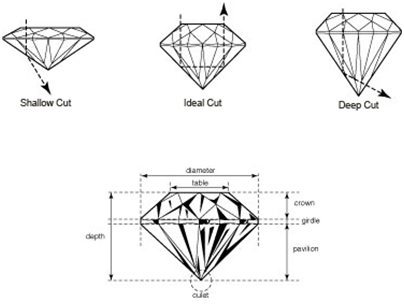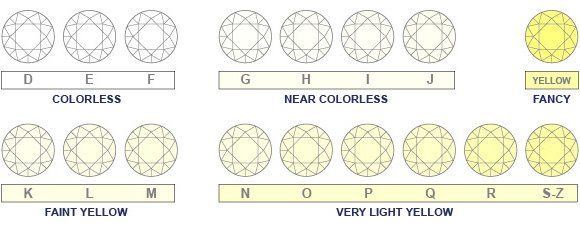Diamond Selection Guide
The Four Cs of Diamonds
Fine diamonds are among the most coveted of all gems. Their value, however, differs widely from one diamond to another. Experts evaluate every diamond for rarity and beauty using four primary guidelines known as the Four Cs; Cut, Colour, Clarity, and Carat Weight.
Cut
When our clients think of the cut they typically think of the shape of the diamond. While cut does refer to shape, it also refers to the proportions of how the diamond is actually cut. Diamonds are cut into many different shapes, reflecting not only popular taste but the proportions and quality of the rough diamond. The most popular shapes include Round, Oval, Square, Princess, Emerald, Baguette, and Marquise cuts. Many speciality shapes are also available.
A diamond’s overall proportions, as well as the size and placement of its many reflective surfaces or facets also play a large part in the cut. The consistency and balance of these can greatly affect how the stone captures light and reflects it back to the eye. In layman’s terms, the cut largely determines the sparkle.
Colour
With the exception of some ‘fancy’ coloured diamonds, the most valuable diamonds are those with the least colour. The colour scale for transparent diamonds runs from D-F (colourless), G-J (near colourless), K-L (faint yellow), to Z (light yellow). Completely colourless diamonds are rare.
When diamonds are formed with traces of other minerals, rare and beautiful colours can result. These ‘fancy’ colours range from blue to brilliant yellow, red, brown, pale green, pink, and violet. Because of their rarity, coloured diamonds are highly desirable and often more valuable.
Clarity
A diamond’s clarity is measured by the existence – or absence – of visible flaws. Tiny surface blemishes or internal inclusions, even those seen only under magnification with a jeweller’s loupe, can alter the brilliance of the diamond and thus affect its value. Clarity levels begin with Flawless (F & IF) and move down to Very, Very Slight (VVS1 & 2), Very Slight (VS1 & 2), Slightly Included (SI1 & 2), and Included (I1, 2 & 3).
FL, IF Diamonds – Flawless: No internal or external flaws. Internally Flawless: No internal flaws
VVS1, VVS2 Diamonds – Very, Very Slightly Included: Very difficult to see inclusions under 10% magnification
VS1, VS2 Diamonds – Very Slightly included: Inclusions are not typically visible to the unaided eye
SI1, SI2 Diamonds – Slightly included: Inclusions are visible under 10× magnification and may be visible to the unaided eye
I1, I2, I3 Diamonds – Included: Inclusions are visible with the unaided eye
Types of Internal Flaws or Inclusions:
- Pinpoints – A small, usually whitish dot that is difficult to see. There can be a number of pinpoints known as a cluster, or a cloud of pinpoints
- Dark Spot – A small crystal inclusion or thin flat inclusion that reflects the light like a mirror
- Colourless crystal – This is a small crystal of diamond and sometimes another mineral
- Cleavage – A small cleavage is a crack that has a flat plane, which if struck in a certain direction, could cause the diamond to split
- Feather – This is another name for a crack. A feather is not dangerous if small and does not open through a facet
- Bearding or girdle fringes – Result from hastiness in the bruting process when giving the diamond its initial shape in the cutting process
- Growth or grain lines – These can only be seen when rotating the diamond slowly during examination. They appear and disappear usually instantaneously and will appear in groups
- Naats or twin lines – Slightly raised dot with a trail resembling a comet
- Laser treatment – A laser is used to make flaws less visible. A black spot can be vaporised and will disappear leaving a void in the diamond.
Types of External Flaws or Blemishes
- Natural – This usually occurs on the girdle and looks like a rough, unpolished area. A natural is a remnant of the original skin of the diamond. It indicates a shortage of rough or that the cutter made the largest acceptable diamond from the material he had to work with
- Nick – This is a small chip, usually on the girdle and can be caused by wear. Sometimes a nick or chip can be seen on the edge of a facet
- Girdle roughness – This blemish appears as crisscrossed lines and can be removed by re-polishing
- Pitts or cavities – Pits or holes on the table facets
- Scratch – A scratch is usually a minor defect that can be removed by re-polishing
- Polishing lines – Many diamonds exhibit polishing lines and are the result of badly maintained polishing wheels
- Abraded or rough culets – The culet has been chipped or poorly finished
- The clarity grade can have a significant effect on the value of a diamond. The price variance between an Internally Flawless diamond and a Very Slightly Included One diamond clarity grade is significant
Carat Weight
The size of a diamond is measured not by its dimensions, but by weight. One carat, the traditional unit of measure for diamonds, is equal to approximately 0.2 grams. You may also hear the weight of a diamond referred to in points. A point is equal to 1/100 of a carat, therefore a 75-point diamond equals 0.75 carat. Diamonds of equal weight may appear slightly different in size, depending on their depth and proportions. Because they are quite rare, larger diamonds of gem quality are much more valuable.
Rarity & Beauty
All gem-quality diamonds are rare, taking billions of years for nature to form them. While the Four Cs information helps you to identify the quality of the diamond you are purchasing, it is the combination of these four characteristics which determine a diamond’s rarity. If you imagine a four-sided pyramid, with each side being a diamond characteristic, the more readily-available diamonds form the base of the pyramid while the rarest diamonds are at the top. Keep this pyramid in mind when you are selecting your diamond. Your selection of characteristics will determine rarity and value. And remember – beauty is in the eye of the beholder. A diamond can only be truly perfect if you think it is beautifully perfect for you.









